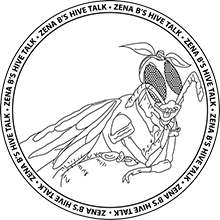Hive Talk - June 2019
The bees are getting down to business

Activity has ramped up quite a bit at ZenaB’s and I’m finding those muscles that I haven’t used since last honey season are waking up and telling me “lift with your legs”! Or, have Dave come and help with the heavy lifting...which he willingly does.
The colonies have settled into the production of making honey, brood (more bees), wax and if needed, a new queen!
Honey: A bee will sip nectar from a flowering plant through her tongue (it’s like a straw) and will store the nectar in a special ‘honey stomach’. Once the ‘stomach’ is full she will go back to the hive and pass it onto the workers in the hive. The workers will then load the nectar into a honeycomb. For nectar to turn into honey the worker bees will sip a droplet of nectar onto their tongue from the honeycomb and roll it around their tongue evaporating the moisture out of the nectar to the point of approximately 18%, Another way bees dehydrate the nectar is to fan it with their wings as well as the heat in the hive. Once the nectar has been turned to honey they will cap the honey comb with wax, which is produced by the younger bees.
We’re talking ‘droplets’ of nectar, smaller than a pinhead. It takes the bees many trips from flowers to the hive to fill one honeycomb and that is only the beginning of the process of making the final decadent miracle of honey.
An average worker bee makes only about 1/12 teaspoon of honey in its lifetime. Worker bees generally live for 6 weeks, a queen bee will live up to 5 years, and a drone (male) will only live for one season, if they don’t mate with a queen. If they do, that is the last act they will do to insure that their colony survives.
There are 3 castes of honey bees in a colony. Workers, drones, and the Queen.
Worker: It takes 21 days for a worker bee to develop. They work their little wings to the bone, and live for 6 weeks. Their job is broken into two main periods; the hive period, and the field period. Each lasting 3 weeks. The workers are all female
Drone: It takes 24 days for a male bee to develop. The queen will only lay drone eggs in the spring and fall. The Drone’s main job is to mate with a queen bee in the spring to ensure the population of the beehive is maintained.
Interesting fact: Once the drones are developed (a week) they fly off in search of a virgin queen. They will fly many kilometers to find her. In some cases drones from nearby colonies will group together in a cloud formation waiting for the queen to find them. The queen gives of a scent which alerts the drones where she is. Once the ritual is completed (with up to 15 drones), the queen returns to her hive to lay eggs all summer long. She can lay upwards to 1,500 eggs a day!
Queen: It takes 16 days for a queen to develop. Her main job is to lay eggs to keep her colony strong. That’s all she does in the hive. Pretty important task, I’d say! The workers will feed, and clean her constantly, and protect her with their lives.
Bee’s Wax is produced by young bees. (Between day 14 and 18.) At that time they secrete scales of wax through glands located under their abdomen. This is what their honeycombs are made of. Each comb is a perfect six-sided tube. The length and width depends on it’s resident; another worker bee, a drone, or a new queen. (But that is another story)
~ ~ ~ ~ ~ ~
This summer I will be monitoring the hives to ensure they are safe, and watered. I offer them a water source so they will not make someone’s hot tub, or leaky hose, their watering hole.
~ ~ ~ ~ ~ ~
We will soon be extracting honey from the hives. There should be enough to sell, so if you want some local raw honey, I will put you on my customer list and let you know when the extracted honey is available.
~ ~ ~ ~ ~ ~
If you happen to find a cluster of bees on your property, they will move on after a few days. This is called a ‘swarm’. They will not be aggressive because they have just gorged themselves with honey before they left the hive. Almost like packing their lunch.
Give me a call and I would be happy to collect them.
This has been fun, see you in the fall...
